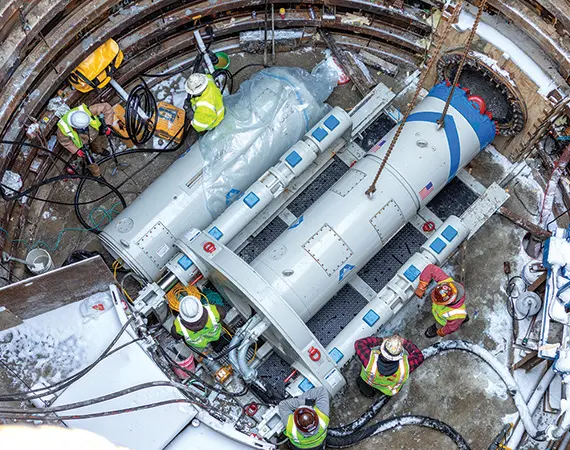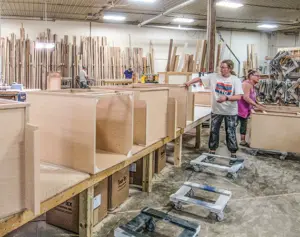From its 78,000-square-foot manufacturing facility in Brownsdale, Akkerman, Inc. produces high-grade tunneling and boring equipment capable of delivering underground water and sewer lines across distances of hundreds of feet and through complex, developed urban areas.
Akkerman’s customers are construction firms — including big industry names — that specialize in trenchless underground construction. Most of the work is in sewer installation, often for municipalities demanding tight tolerances while navigating existing gas and water lines, through pressurized ground and under rivers, and beneath functioning roads and railways.
Company president Justin Akkerman says his company prides itself on precision, based on decades of research and development. That product, however, depends on skilled operators, and the industry it supports is facing increased turnover and a need for faster and more effective equipment training at greater scale.
For a company with a history of innovation, it’s just another opportunity knocking.
Pipe jacking
Akkerman, Inc. today got its start in the late 1950s as D.H. Akkerman Construction. Don (D.H.) Akkerman and his small team dug out trenches, laid pipe, and backfilled it all with soil. It was exhausting and time consuming. Where construction needed to take place under existing roadways, pits were excavated on either side of the road. Below ground level, one man would work to shovel out soil while others used mechanical jacks to push pipe farther into the excavated space.
Push the pipe forward, retract the jacks, set a new pipe, weld, push, repeat: They call it pipe jacking.
By 1963 the company developed its first tunnel boring machine (TBM) to increase both safety and efficiency. D.H.’s accountant suggested selling the innovative TBMs to other construction firms, and in 1973 Akkerman, Inc. was born.
Decades of research and development have refined those early machines through improved materials and processes and the addition of high-tech solutions, like laser guidance systems. Akkerman now handles three main product lines, which include the more traditional manned TBM machines for larger applications, smaller remote systems for pipes with a diameter under four feet, and specialized machines for working in pressurized ground, such as under rivers.
Justin Akkerman, grandson of D.H., acknowledges that it’s a niche market, but one where the company stands out by standing behind its product.
That begins at the point of delivery. New customers receive on-site training from Akkerman’s traveling technicians before their operators handle new equipment. The model has worked well enough, but an active work location in the middle of a contract has never been the ideal space to hold class — idling construction sites bleed money.
“A lot of this is labor,” Akkerman explains, saying that the costs add up for his company and his clients. They needed a new way to train.
Experience at hand
The solution was to create a roughly quarter-million-dollar training facility at Akkerman, Inc.’s 83-person headquarters. In early July, the company began construction of a 140-foot-wide above-ground training center. Built in a fashion not unlike a raised garden bed, the structure will be divided into three 40-foot-long channels that stand approximately six feet tall and are filled with materials ranging from soil to rocks.
Customers will send their teams to Akkerman to train upon hiring or during down time, reducing losses to delayed work. Akkerman will still send its technicians out on site to help with new equipment as needed, but much of the training can be handled in Brownsdale.
“You’re at our facility, you have a lot of resources. You’re not under the gun, on the schedule,” Akkerman explains.
The facility will also enable Akkerman to train its new technicians at home and greatly reduce costs for research and development. In the past, the company has collaborated with clients to schedule time to test out new and prototype equipment at active project sites. The real-world testing is informative, but having to impede on a client’s work can strain relationships and mean that failed prototypes fail publicly rather than privately.
“It will be huge for us to do any type of research and development at our facility prior to getting with our customers,” Akkerman says, noting that the new facility will allow analyzing a broader range of products in more realistic circumstances without leaving home.
As one final benefit, clients visiting the Akkerman HQ to view products in person will now be able to see a broad assortment of equipment in use after minimal setup — something Akkerman believes will raise his customers’ product awareness.
“I think there’s a better value if we can get our customers to our facility — see our people, see our equipment, interact with everyone,” Akkerman says. “That is money well spent.” He explains that in the past few years the company has diminished its presence at trade shows, due largely to the costly nature of setup and transporting heavy equipment.
The Akkerman, Inc. training center is expected to open in September.
“The concept as a whole is really quite innovative,” says Enterprise Minnesota’s Business Growth Consultant Abbey Hellickson. “It’s such a great way for them to interact with their customers and bring their customers into their facility and engage on a very different level than what they’ve done before.”
Return to the Fall 2023 issue of Enterprise Minnesota® magazine.

